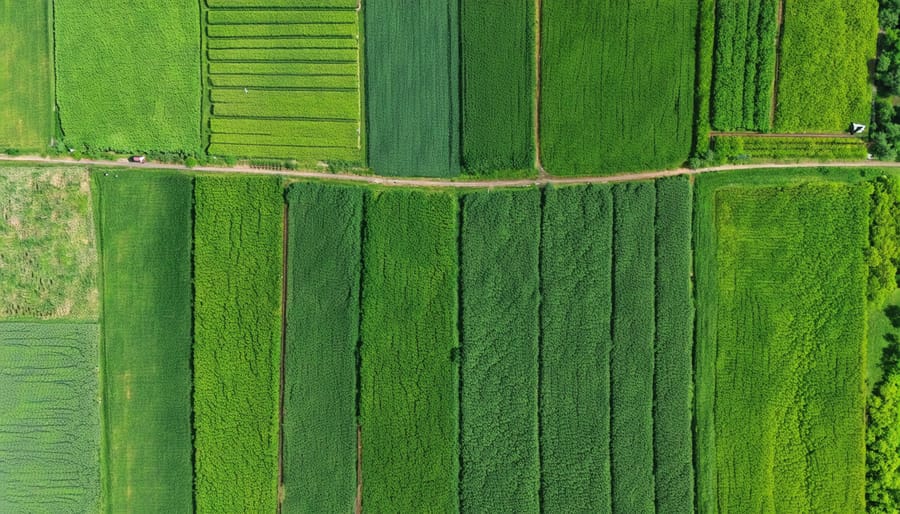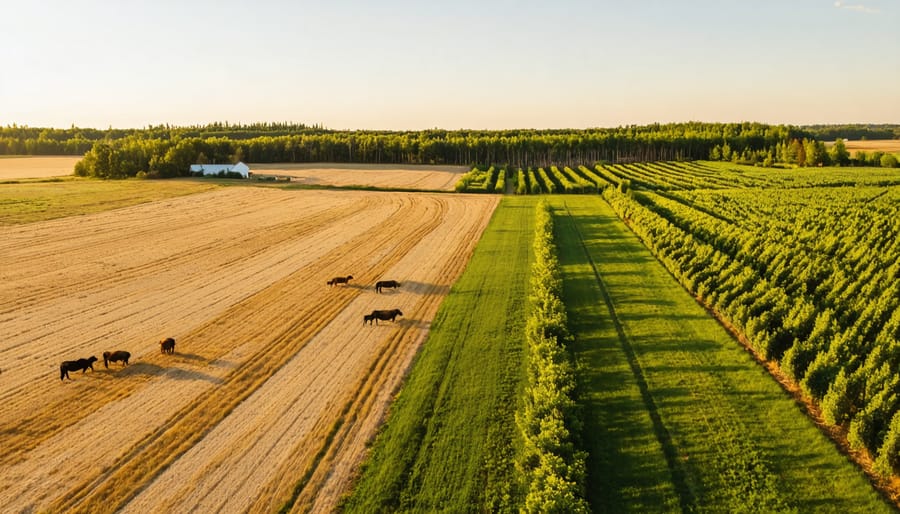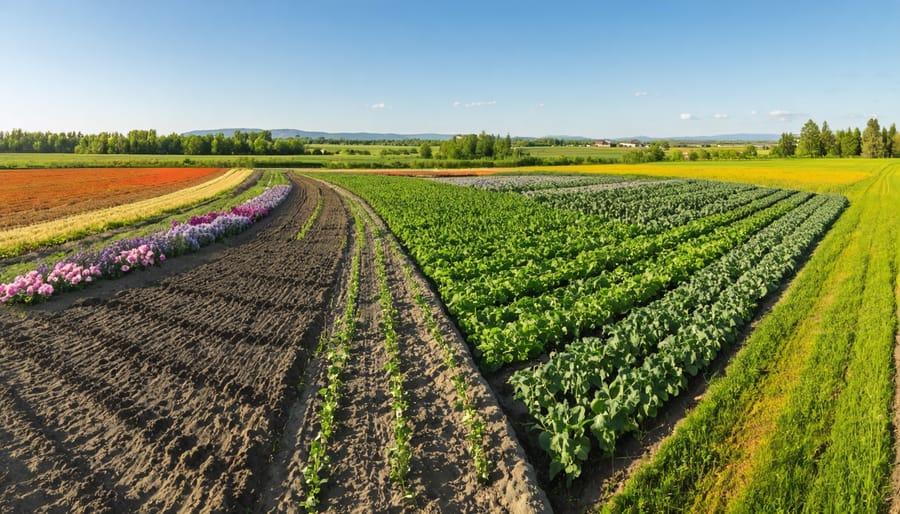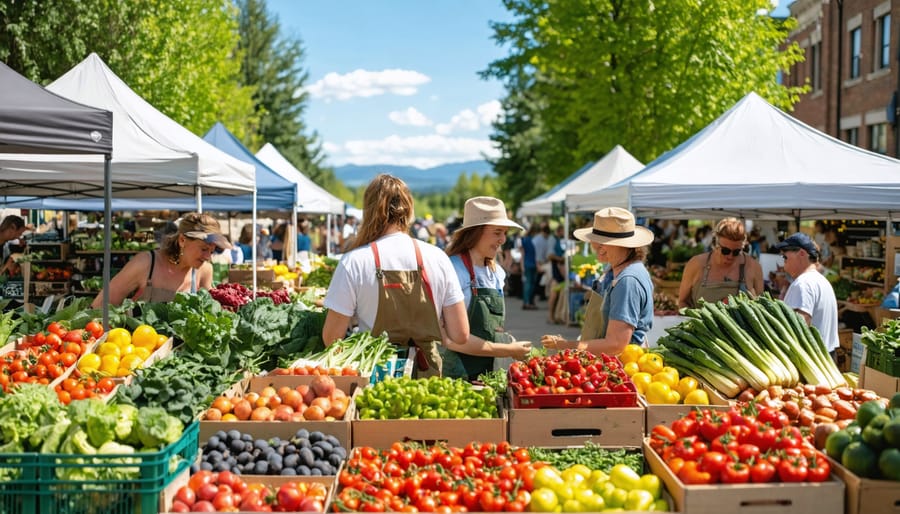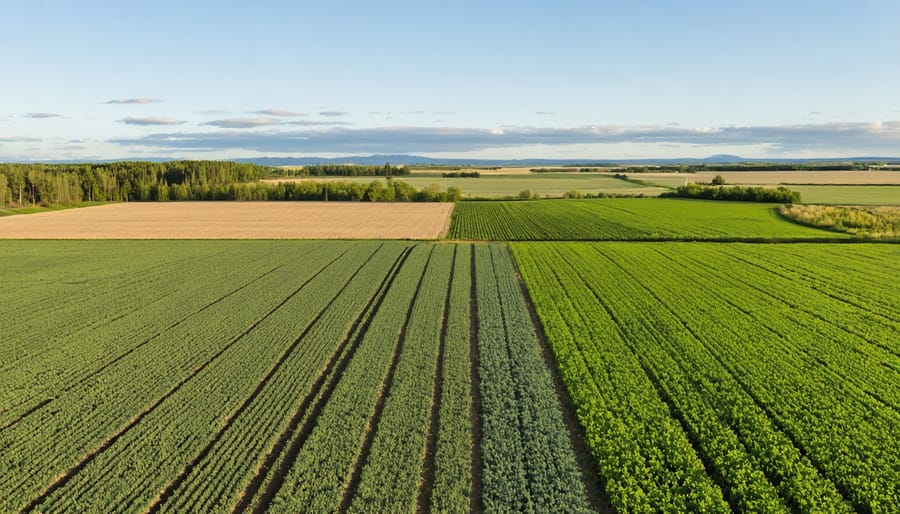Transform conventional farmland into resilient ecosystems by implementing sustainable agroecology practices that integrate natural cycles with food production. Canadian farmers are revolutionizing agriculture by combining traditional knowledge with modern innovation, creating systems that work with nature rather than against it.
Across Alberta’s diverse landscapes, from Prairie grasslands to parkland regions, farmers are achieving remarkable results: 40% reduction in input costs through integrated pest management, 60% improvement in soil organic matter through cover cropping, and 30% increase in water retention through strategic crop rotation. These methods not only protect our environment but also strengthen farm viability for future generations.
Agroecology represents more than sustainable farming—it’s a practical approach to building agricultural resilience while maintaining profitable operations. By embracing ecological principles, Canadian producers are creating farming systems that withstand climate pressures, reduce dependency on external inputs, and produce nutrient-dense foods that command premium market prices.
The shift toward agroecological methods isn’t just environmentally sound—it’s economically imperative. With input costs rising and weather patterns becoming increasingly unpredictable, these practices offer a proven path to farm sustainability and profitability. The time for transition is now, and the benefits are clear: healthier soils, stronger communities, and more resilient farm businesses.

Agroecology: The Foundation of Sustainable Farming in Alberta
Local Success Stories: Alberta Farmers Leading the Way
The Stettler region’s Davidson Family Farm stands as a shining example of successful agroecological transition in Alberta. Over the past decade, Sarah and Mike Davidson have transformed their 800-hectare conventional grain operation into a diverse, regenerative farming system. By implementing cover cropping and reducing tillage, they’ve increased their soil organic matter by 2% while cutting fertilizer costs by 40%.
“The key was starting small and learning from each season,” shares Sarah Davidson. “We began with a 40-hectare test plot for cover crops, and now we’ve scaled these practices across our entire operation.” The Davidsons’ success has inspired neighbouring farms to adopt similar practices.
In the Peace Country region, the Martinez Family showcases how livestock integration can enhance farm resilience. Their 400-hectare operation combines rotational grazing with annual cropping, using cattle to manage cover crops and crop residues. This system has reduced their feed costs by 30% while improving soil health and biodiversity.
The Lethbridge area’s Singh Agricultural Cooperative demonstrates the power of community-based farming. Five family farms collaborated to implement a shared rotation system, allowing for more diverse crop sequences and integrated pest management. Their collective approach has resulted in a 25% reduction in pesticide use and improved market access for specialty crops.
These success stories share common elements: careful planning, gradual implementation, and a willingness to adapt. The farmers emphasize the importance of networking with other producers and accessing technical support through local agricultural extension services.
As Ray Thompson, a regenerative agriculture consultant in Red Deer, notes, “These farmers are proving that agroecological practices can work in Alberta’s diverse growing conditions. Their success isn’t just environmental – they’re seeing real economic benefits while building more resilient farming systems.”
The documented improvements in soil health, reduced input costs, and enhanced farm profitability provide compelling evidence for other Alberta farmers considering the transition to agroecological practices.
Natural Systems at Work: Understanding Your Farm’s Ecosystem
Every farm is a living, breathing ecosystem where countless natural processes work together to support agricultural production. Understanding these interconnections can help you harness nature’s power to enhance your farm’s productivity while reducing input costs. When you implement regenerative farming practices, you’re essentially partnering with these natural systems rather than working against them.
Consider the soil food web beneath your feet: beneficial bacteria and fungi break down organic matter, making nutrients available to your crops. Earthworms create channels that improve water infiltration and soil structure. Above ground, pollinators and beneficial insects work tirelessly to support crop production and manage pest populations naturally.
Here in Alberta, we’ve seen how native prairie species can contribute to farm resilience. Deep-rooted perennials help prevent soil erosion and improve water retention, while hedgerows and shelterbelts provide habitat for beneficial wildlife and protect crops from harsh winds.
These ecological interactions create valuable synergies. For example, maintaining diverse plant species supports robust pollinator populations, which in turn increases crop yields. Healthy soil biology improves nutrient cycling, reducing the need for synthetic fertilizers. Even weeds, often viewed as problems, can indicate soil conditions and sometimes provide benefits like drawing up deep nutrients or preventing erosion.
By observing and working with these natural systems, you can create a more resilient and productive farm that requires fewer external inputs. Start by mapping the ecological assets on your land – from wetlands to windbreaks – and consider how each element contributes to your farm’s overall health and productivity.
Practical Steps to Transform Your Farm
Soil Health Management in Alberta’s Climate
Alberta’s unique climate presents both challenges and opportunities for soil health management. Our province’s diverse soil types, from rich black chernozems to brown soils in drier regions, require tailored approaches to maintain and enhance their fertility. By implementing region-specific practices, farmers across Alberta are discovering innovative ways to improve soil health while achieving carbon sequestration benefits.
Cover cropping has proven particularly effective in our climate, with cold-hardy species like fall rye and winter wheat providing soil protection during harsh winters. Many Alberta farmers are successfully integrating living root systems throughout the growing season, which helps maintain soil structure and supports beneficial microorganism populations.
Reduced tillage practices, adapted for our shorter growing season, have shown remarkable results in moisture retention and erosion control. Local farmers report significant improvements in soil organic matter levels after transitioning to minimal soil disturbance systems, particularly in areas receiving less than 450mm of annual precipitation.
Crop rotation diversity is another crucial element, with successful Alberta farmers incorporating pulses and oilseeds alongside traditional cereals. This practice not only enhances soil biology but also provides natural nitrogen fixation, reducing the need for synthetic inputs.
Recent field studies in Central Alberta demonstrate that incorporating livestock through adaptive grazing can accelerate soil regeneration. Farmers using this integrated approach report improved water infiltration rates and increased soil carbon levels within three to five years of implementation.
For best results in our climate, consider:
– Selecting cover crop species that establish quickly in cool conditions
– Timing tillage operations to minimize moisture loss
– Managing crop residue to protect soil during winter
– Monitoring soil temperature for optimal biological activity
– Adjusting practices based on local precipitation patterns
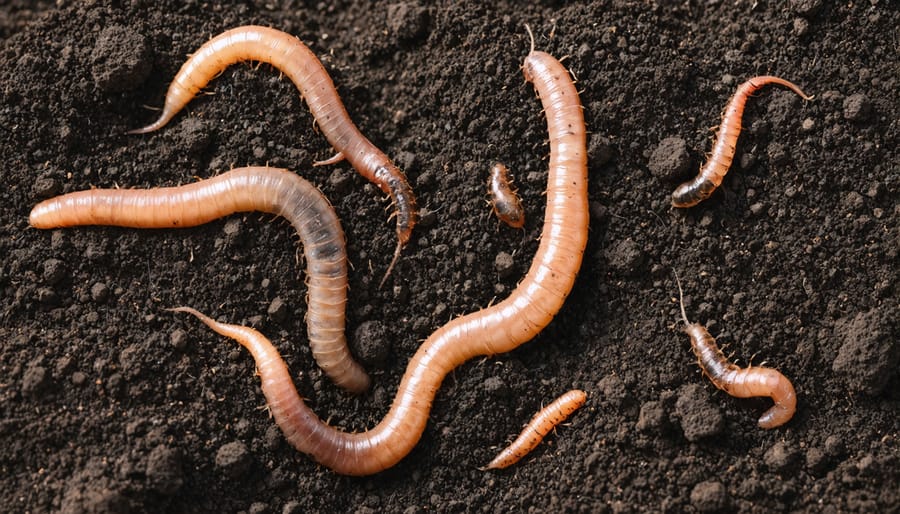
Building Biodiversity on Your Land
Building biodiversity on your farm isn’t just about conservation – it’s a smart farming strategy that can significantly reduce pest problems and enhance crop resilience. Here in Alberta, successful farmers are creating diverse ecosystems by implementing strategic plantings and habitat zones.
Start by establishing hedgerows and windbreaks using native species like trembling aspen, wild rose, and chokecherry. These natural barriers not only protect your crops from wind damage but also provide habitat for beneficial insects and birds that control pest populations naturally.
Consider leaving field margins unmowed and planting wildflower strips between crop rows. Local species like goldenrod and yarrow attract pollinators and predatory insects that help manage harmful pests. Many Alberta farmers have found success with beetle banks – raised strips of native grasses that harbour ground beetles and other beneficial insects.
Water features like small ponds or wetland areas can dramatically increase biodiversity. Even a simple dugout can attract insect-eating birds and provide habitat for beneficial amphibians. During dry spells, these water sources become crucial refuge points for wildlife that support your farming ecosystem.
Rotate your crops and include flowering cover crops like clover or vetch in your rotation. This practice not only improves soil health but also creates year-round habitat for beneficial insects. Remember, a diverse landscape is a resilient landscape – the more variety you can incorporate, the more stable and productive your farm ecosystem will become.
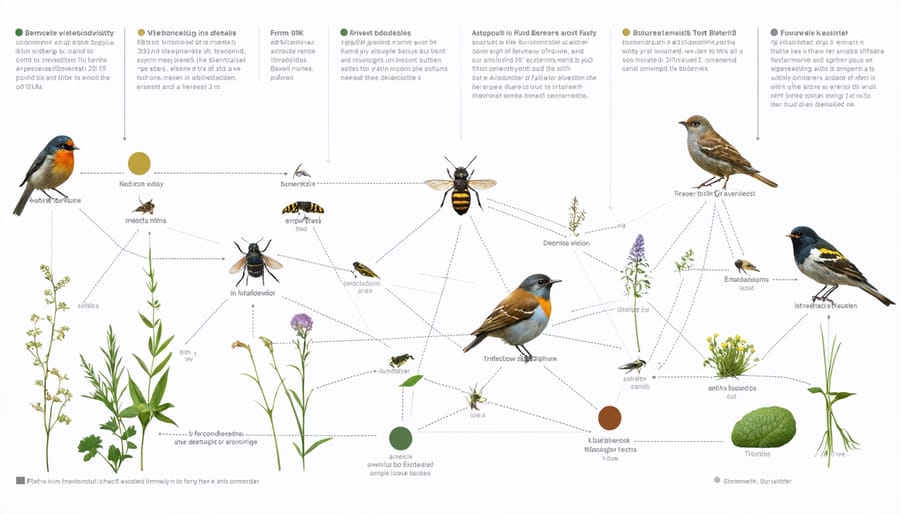
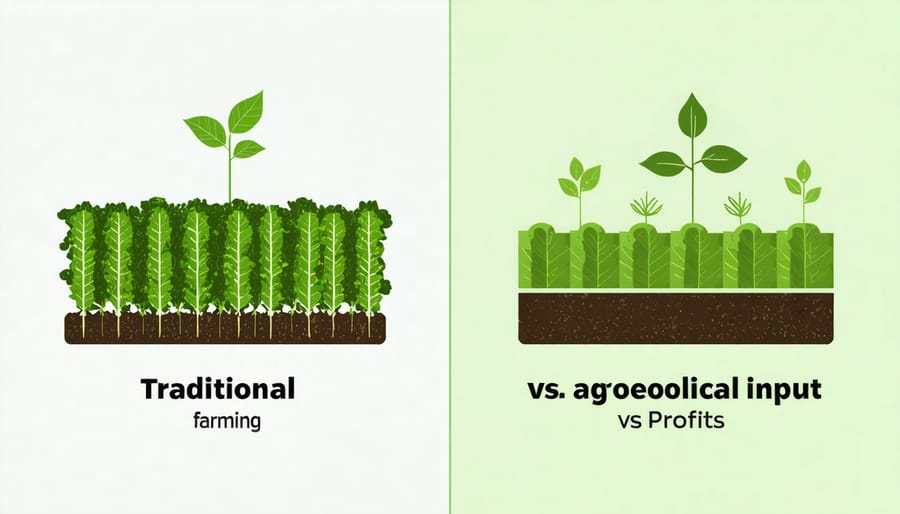
Economic Benefits of Agroecological Farming
Reducing Input Costs Through Natural Systems
Implementing agroecological practices can significantly boost farm profits by reducing dependency on expensive external inputs. Many Alberta farmers have discovered that working with natural systems, rather than against them, leads to substantial cost savings.
Cover cropping and crop rotation naturally enhance soil fertility, reducing the need for synthetic fertilizers. For example, including nitrogen-fixing legumes in rotation can save up to $100 per hectare in fertilizer costs. Integrated pest management strategies, such as encouraging beneficial insects and maintaining habitat diversity, can cut pesticide expenses by 30-50%.
Natural windbreaks and shelterbelts not only protect crops but also reduce irrigation needs by decreasing evaporation. Some Prairie farmers report water savings of up to 25% after establishing these features. Composting farm waste and managing livestock grazing patterns further minimize the need for purchased inputs while improving soil health.
These practices typically show returns within 2-3 growing seasons, with long-term benefits accumulating as soil health improves and ecosystem services strengthen.
Market Opportunities for Sustainable Products
The growing demand for sustainably produced food has created exciting market opportunities for Canadian farmers embracing agroecological practices. Premium markets are increasingly willing to pay more for products that demonstrate environmental stewardship and social responsibility. By participating in local food systems, farmers can build direct relationships with consumers who value sustainable practices.
Value-added opportunities include organic certification, which typically commands price premiums of 20-100% above conventional products. Other certification programs, such as regenerative agriculture verification and sustainable livestock protocols, are gaining traction in Canadian markets. Many Alberta farmers have found success through farm-gate sales, farmers’ markets, and community-supported agriculture programs.
Processing and packaging innovations can further increase product value. Examples include on-farm grain cleaning and packaging, specialty flour milling, and value-added dairy products. These enterprises not only improve profit margins but also create additional employment opportunities within rural communities. Collaboration with local restaurants, schools, and institutions can provide stable markets while supporting regional food security initiatives.
As we’ve explored throughout this article, agroecology offers practical solutions for Canadian farmers looking to build more sustainable and resilient agricultural systems. By integrating ecological principles with traditional farming knowledge, you can enhance soil health, reduce input costs, and create more stable income streams while contributing to environmental conservation.
Taking the first step toward agroecological practices doesn’t require a complete farm overhaul. Start small by implementing cover cropping or introducing beneficial insects into your operation. Connect with local farming networks and agricultural extension services in Alberta to learn from others who have successfully transitioned to sustainable practices.
Remember that government programs and grants are available to support your transition. Consider joining farmer-to-farmer mentorship programs or participating in field days to gain hands-on experience. Document your progress, including soil tests and yield data, to track improvements and adjust your approach as needed.
The future of Canadian agriculture lies in building resilient, sustainable systems that work with nature rather than against it. Your journey toward agroecological practices not only benefits your farm’s bottom line but also contributes to a healthier environment for future generations.

